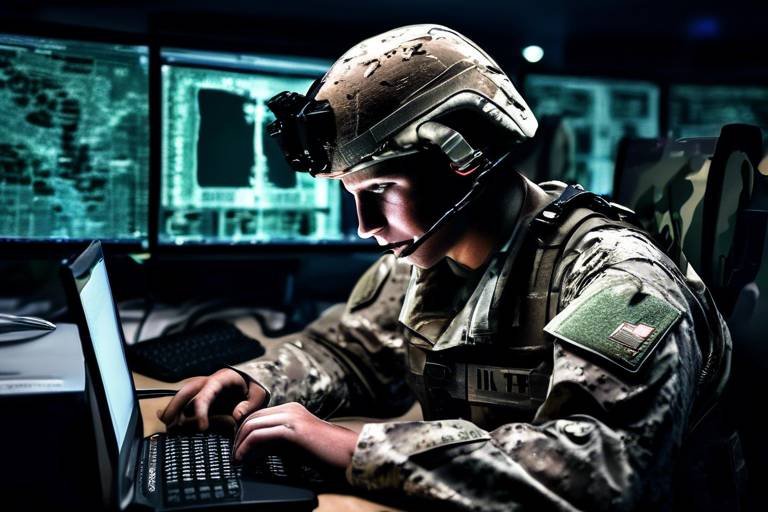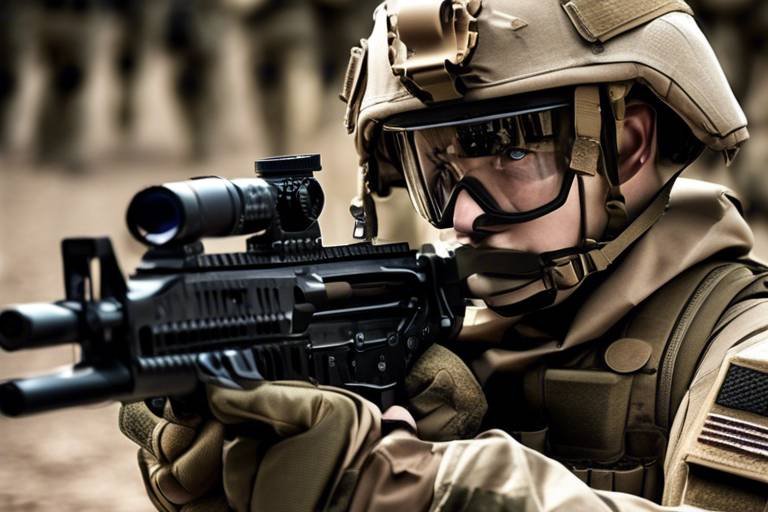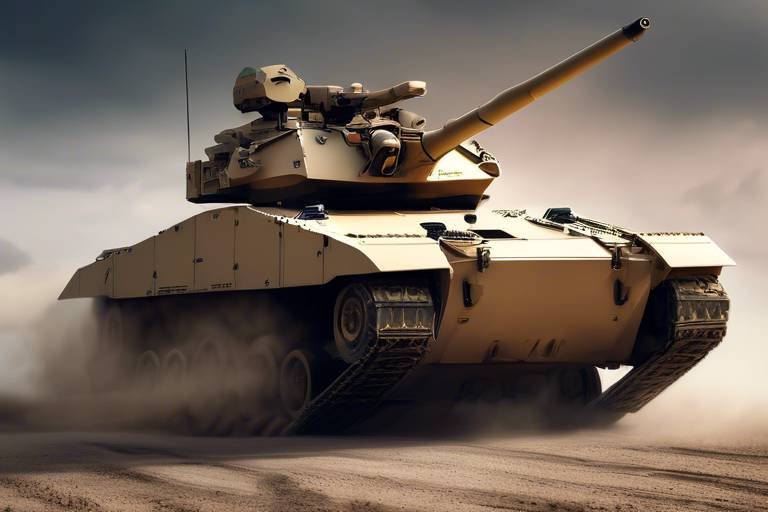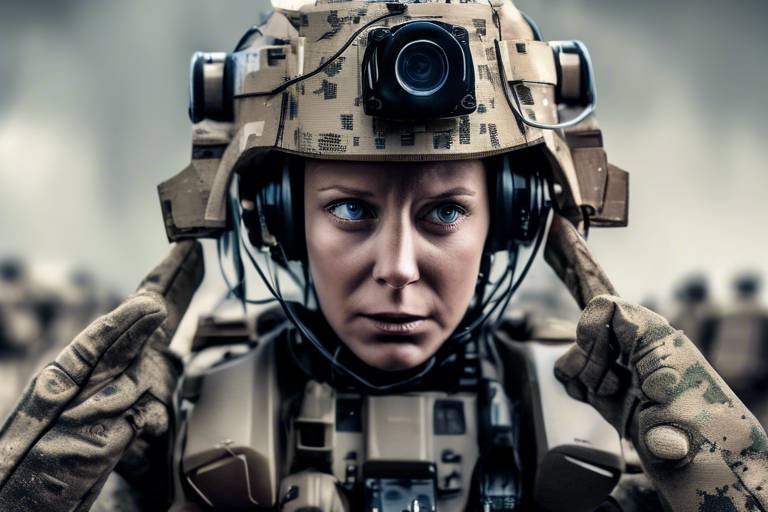How AI is Reshaping Battlefield Communication Technologies
The landscape of military operations has undergone a dramatic transformation in recent years, primarily due to the advent of artificial intelligence (AI). This technology is not just a buzzword; it’s a game-changer that is reshaping how armed forces communicate on the battlefield. Imagine a scenario where soldiers can communicate seamlessly, share real-time data, and make informed decisions faster than ever before. Sounds like science fiction, right? Well, it's becoming a reality! AI is enhancing communication technologies in ways that can significantly impact operational effectiveness.
At its core, AI is about processing vast amounts of data and making sense of it quickly. In military communication, this translates to improved information processing, decision-making speed, and overall operational efficiency. When troops are in the heat of battle, every second counts. AI helps to streamline communication channels, allowing for more effective coordination and response during combat situations. It’s like having a trusted advisor that can analyze data and provide insights at lightning speed.
But what does this mean for the future of military operations? With AI, we’re looking at a future where communication is not just about sending messages; it’s about creating a dynamic information network that evolves in real-time. This can lead to better situational awareness, improved tactical planning, and ultimately, a higher chance of mission success. As we dive deeper into the advancements, challenges, and future directions of AI in military communication, it’s clear that we are on the brink of a new era in warfare.
AI technologies are revolutionizing military communication by enhancing information processing, decision-making speed, and operational efficiency, allowing for more effective coordination and response during combat situations. With these advancements, military leaders can leverage AI to analyze data from various sources, including drones, surveillance systems, and ground forces, all in real-time. This capability not only aids in crafting strategies but also in anticipating enemy movements, thus giving a tactical advantage.
Recent developments in AI-driven communication systems have introduced innovative tools such as real-time translation, automated reporting, and predictive analytics. These technologies significantly improve situational awareness and strategic planning on the battlefield. For instance, real-time translation technologies allow personnel from different countries to communicate effectively, breaking down language barriers that could otherwise hinder joint operations.
AI-powered translation tools facilitate seamless communication between multinational forces, ensuring accurate information exchange. This is crucial for successful joint operations, where miscommunication can lead to disastrous outcomes. Machine learning algorithms enhance translation accuracy by continuously learning from new data, adapting to specific military jargon and context, thus improving operational effectiveness in diverse environments.
Machine learning algorithms are the backbone of these translation technologies. They not only translate words but also understand context, tone, and urgency, which are vital in military communication. Imagine a scenario where a commander needs to relay urgent instructions to allied forces in a different language. With AI-driven translation, these instructions can be conveyed accurately and swiftly, reducing the risk of misunderstandings.
The integration of real-time translation technologies in command and control systems fosters better collaboration among units. This leads to faster decision-making and improved mission outcomes in complex scenarios. When every unit can understand each other without delay, the battlefield becomes a more cohesive environment, allowing for synchronized operations that can overwhelm adversaries.
Automated reporting systems powered by AI streamline data collection and dissemination. They reduce the burden on personnel, ensuring timely updates for commanders and decision-makers during critical operations. Imagine a battlefield where reports are generated automatically, summarizing key data points and providing actionable insights. This not only saves time but also allows human operators to focus on strategic thinking rather than getting bogged down by data entry.
Despite the benefits, the integration of AI in military communication faces challenges such as cybersecurity threats, data privacy concerns, and the need for robust infrastructure to support advanced technologies. As AI systems become integral to military communication, they also present new cybersecurity vulnerabilities that adversaries may exploit. Therefore, enhanced security measures are crucial to protect sensitive information.
With the increasing reliance on AI, the military must address the potential cybersecurity risks that come with these technologies. Adversaries may attempt to infiltrate AI systems to manipulate data or disrupt communication channels, which could have catastrophic consequences on the battlefield. Thus, developing robust cybersecurity protocols is paramount.
Implementing AI technologies requires significant investment in infrastructure, including reliable networks and data management systems. This poses logistical challenges for military organizations, especially in remote or hostile environments. Ensuring that troops have access to the necessary technology and support is essential for maximizing the benefits of AI in military communication.
The future of AI in battlefield communication looks promising, with ongoing research and development aimed at creating more sophisticated systems that enhance interoperability, adaptability, and resilience in dynamic combat environments. As technology continues to advance, we can expect AI to play an even more critical role in shaping military strategies and enhancing the effectiveness of communication on the battlefield.
- What is the main benefit of AI in military communication? AI enhances the speed and accuracy of communication, allowing for quicker decision-making and improved coordination among military units.
- How does real-time translation work in military operations? Real-time translation uses AI algorithms to convert spoken or written language instantly, enabling seamless communication between forces from different countries.
- What are the cybersecurity concerns surrounding AI in the military? AI systems can be vulnerable to cyber-attacks, which may lead to data manipulation or communication disruptions, necessitating robust security measures.
- What challenges do military organizations face when implementing AI technologies? Key challenges include the need for significant infrastructure investment, cybersecurity risks, and ensuring reliable data management systems.

The Role of AI in Military Communication
Artificial Intelligence (AI) is not just a buzzword; it’s a game-changer in military communication. Imagine a battlefield where every piece of information flows seamlessly, decisions are made at lightning speed, and coordination among troops is as smooth as a well-oiled machine. That’s the promise of AI in military settings. By harnessing the power of AI technologies, military organizations are enhancing their information processing capabilities, significantly speeding up decision-making, and boosting overall operational efficiency.
In the chaos of combat, every second counts. The ability to communicate effectively can mean the difference between mission success and failure. AI is stepping in to streamline this process. For instance, AI systems can analyze vast amounts of data in real-time, identifying patterns and insights that human operators might miss. This capability allows commanders to make informed decisions quickly, adapting to rapidly changing situations on the ground.
Furthermore, AI enhances coordination among various military units, ensuring that everyone is on the same page. This is particularly crucial in joint operations involving multiple nations, where language barriers can hinder communication. AI-driven tools can translate messages in real-time, facilitating smooth interactions and reducing the potential for misunderstandings. It's like having a universal translator right in the command center!
Moreover, the integration of AI into military communication systems is not just about speed; it's also about reliability. AI can help filter out noise from critical information, ensuring that only the most pertinent data reaches decision-makers. This can be likened to having a personal assistant who sorts through mountains of paperwork to present only the most important documents for your review. In high-stakes environments, such reliability is invaluable.
However, it’s important to note that the implementation of AI technologies in military communication is not without its challenges. Issues such as cybersecurity threats and the need for robust infrastructure can complicate the integration process. But despite these hurdles, the potential benefits of AI in enhancing military communication are too significant to ignore.
In summary, AI is revolutionizing military communication by improving information processing, speeding up decision-making, and enhancing operational efficiency. As these technologies continue to evolve, we can expect to see even more innovative applications that will further transform how military forces communicate and operate on the battlefield.
- What is the primary benefit of AI in military communication?
AI enhances speed and accuracy in communication, allowing for quicker decision-making and improved operational efficiency. - How does AI help with language barriers in joint operations?
AI-powered translation tools facilitate real-time communication between multinational forces, breaking down language barriers. - What are some challenges faced in implementing AI technologies?
Challenges include cybersecurity risks, data privacy concerns, and the need for significant infrastructure investment. - What does the future hold for AI in military communication?
The future looks promising, with ongoing research focused on creating more sophisticated systems that enhance interoperability and resilience.

Advancements in AI-Driven Systems
In recent years, we have witnessed a remarkable evolution in AI-driven communication systems that are fundamentally changing the landscape of military operations. These advancements are not just incremental; they represent a paradigm shift that enables forces to operate with unprecedented efficiency and effectiveness. Imagine a battlefield where information flows seamlessly, decisions are made in real-time, and every soldier is equipped with the tools necessary to respond to rapidly changing scenarios. This is the reality that AI is helping to create.
One of the most significant innovations is the development of real-time translation technologies. These AI-powered tools have the power to break down language barriers that have historically hampered multinational operations. For example, during joint missions involving troops from different countries, the ability to translate commands, reports, and tactical information instantly can be the difference between success and failure. The implications are enormous, as they foster collaboration and unity among diverse forces, ensuring that everyone is on the same page—literally.
AI-driven translation tools utilize advanced machine learning algorithms to enhance their performance continually. These algorithms are designed to learn from vast amounts of data, which means they can adapt to specific military jargon and contextual nuances. This adaptability is crucial in the field, where the stakes are high, and every word counts. By improving translation accuracy, these systems not only facilitate communication but also enhance operational effectiveness in diverse environments.
Consider this: a soldier in a combat zone receives a message in a foreign language. With AI-powered translation tools, that message can be translated instantaneously, allowing the soldier to act without delay. This capability is made possible by machine learning algorithms that are constantly refining their understanding of language and context. The result? A more cohesive and coordinated response to threats, ultimately leading to better mission outcomes.
The integration of real-time translation technologies into command and control systems is revolutionizing how military units collaborate. By enabling faster decision-making, these advancements ensure that commanders have access to accurate information when it matters most. Imagine a scenario where a commander can communicate with allied forces in different languages without any loss of meaning or urgency. This level of collaboration not only enhances situational awareness but also fosters trust among allied forces, which is essential for successful joint operations.
Another groundbreaking advancement in AI-driven systems is the emergence of automated reporting systems. These systems leverage AI to streamline the collection and dissemination of data, reducing the burden on personnel. When every second counts, having timely updates can significantly influence the course of action. Automated reporting ensures that commanders receive the information they need without delay, allowing them to make informed decisions quickly.
By automating routine reporting tasks, military personnel can focus on more strategic responsibilities. This shift not only improves operational efficiency but also reduces the risk of human error in critical communications. With AI handling the heavy lifting, commanders can trust that the information they receive is accurate and up-to-date, allowing them to allocate resources effectively and respond to emerging threats.
In summary, the advancements in AI-driven communication systems are not just enhancing the way military forces operate; they are fundamentally transforming the battlefield landscape. With real-time translation technologies and automated reporting systems, military units can achieve a level of coordination and responsiveness that was previously unimaginable. As we look towards the future, the potential for these technologies to further enhance operational effectiveness is boundless.
- What are AI-driven communication systems?
AI-driven communication systems utilize artificial intelligence to enhance the processing and dissemination of information in military operations. - How do real-time translation technologies work?
These technologies use machine learning algorithms to translate languages instantly, adapting to military jargon and context for improved accuracy. - What are the benefits of automated reporting systems?
Automated reporting systems streamline data collection, reduce personnel workload, and ensure timely updates for decision-makers. - What challenges do AI technologies face in military communication?
Challenges include cybersecurity threats, data privacy concerns, and the need for robust infrastructure.

Real-Time Translation Technologies
In the fast-paced world of military operations, effective communication can mean the difference between success and failure. are stepping up to the plate, revolutionizing how multinational forces interact on the battlefield. Imagine a scenario where soldiers from different countries are working side by side, each speaking their native languages. In the past, this could lead to misunderstandings and errors that jeopardize missions. However, with the advent of AI-powered translation tools, those barriers are rapidly dissolving.
These technologies utilize advanced algorithms to facilitate seamless communication, ensuring that critical information flows freely and accurately between units. For instance, if a commander needs to relay important tactical information to allied forces, real-time translation systems can instantly convert spoken or written messages into the desired language. This capability is not just a luxury; it’s a necessity in joint operations where every second counts.
One of the most fascinating aspects of these translation technologies is their reliance on machine learning algorithms. These algorithms continuously learn and adapt, improving their translation accuracy over time. They analyze vast amounts of data, including military jargon, slang, and context-specific phrases, enabling them to deliver nuanced translations that resonate with the intended audience. This means that as soldiers use these systems, they become more effective at communicating complex ideas, strategies, and commands.
Moreover, the integration of real-time translation into command and control systems enhances collaboration among units. It fosters an environment where soldiers can share insights and strategies without the fear of miscommunication. For example, during a joint exercise, a U.S. commander can communicate tactical maneuvers to a coalition partner in real time, leading to faster decision-making and improved mission outcomes. The ripple effect of this technology is profound, as it not only enhances operational effectiveness but also builds trust and camaraderie among international forces.
However, it’s essential to recognize that while real-time translation technologies offer remarkable benefits, they are not without challenges. The accuracy of translations can vary, particularly in high-stress situations where clarity is paramount. Additionally, reliance on technology raises questions about data security and the potential for cyber threats. As military organizations increasingly adopt these systems, they must also implement robust cybersecurity measures to safeguard sensitive information.
In summary, real-time translation technologies are transforming battlefield communication, breaking down language barriers, and fostering collaboration among multinational forces. The ability to communicate effectively in real time is not just about convenience; it’s about enhancing operational efficiency and ensuring mission success in an increasingly complex global landscape. As these technologies continue to evolve, we can expect even greater advancements that will further solidify their role in military operations.
- How do real-time translation technologies work? These technologies use AI and machine learning algorithms to instantly convert spoken or written language into another language, facilitating seamless communication.
- What are the benefits of using real-time translation in military operations? The main benefits include improved communication, faster decision-making, and enhanced collaboration among multinational forces.
- Are there any challenges associated with real-time translation technologies? Yes, challenges include potential inaccuracies in high-stress situations and the need for robust cybersecurity measures to protect sensitive information.

Machine Learning Algorithms in Translation
Machine learning algorithms have become the backbone of modern translation technologies, especially in military communication contexts. These algorithms are designed to learn from vast amounts of data, enabling them to improve their translation accuracy over time. Imagine a translator that not only understands basic phrases but also adapts to the unique jargon used by military personnel. This is exactly what machine learning achieves. By continually analyzing new data, these systems can refine their understanding of context, slang, and even the emotional tone of communications, making them invaluable during operations.
For instance, when soldiers from different countries collaborate, they often encounter specialized terminologies and acronyms that are not present in standard language dictionaries. Machine learning algorithms can be trained on specific military datasets, allowing them to recognize and accurately translate these terms. This capability is crucial in high-stakes environments where every word counts, and miscommunication can lead to dire consequences. The algorithms work by employing techniques such as neural networks, which mimic the way human brains process information, enhancing their ability to deliver precise translations.
Moreover, the integration of machine learning in translation systems significantly impacts operational effectiveness. By providing real-time translations, these systems allow commanders to communicate seamlessly with multinational forces, ensuring that everyone is on the same page. This not only accelerates decision-making processes but also enhances teamwork and trust among allied units. Imagine a scenario where a commander can instantly translate critical orders into multiple languages, ensuring that every soldier understands their role without delay.
However, the journey of machine learning in translation is not without its challenges. Data privacy is a significant concern, as sensitive military information must be protected from unauthorized access while still allowing the algorithms to learn effectively. Additionally, the reliance on technology raises questions about the potential for errors in translation, which could occur if the system encounters unfamiliar terms or contexts. To mitigate these risks, military organizations must invest in robust training protocols and continually update their systems with the latest data.
In conclusion, machine learning algorithms are revolutionizing translation technologies in military settings by providing more accurate, context-aware translations. As these systems continue to evolve, they promise to enhance communication, foster collaboration, and ultimately contribute to more successful outcomes on the battlefield.
- What are machine learning algorithms? Machine learning algorithms are systems that learn from data to improve their performance over time, often used in translation technologies to enhance accuracy and context understanding.
- How do machine learning algorithms improve translation? They analyze vast datasets, adapt to specific terminologies, and learn from new information to provide more accurate translations in real-time.
- What challenges do military organizations face with AI in translation? Key challenges include data privacy concerns, the potential for translation errors, and the need for ongoing system updates and training protocols.
- Are machine learning translation systems reliable? While they are highly effective, there is always a risk of errors, particularly with unfamiliar terms. Continuous training and data updates can help mitigate these issues.

Impacts on Command and Control
The integration of real-time translation technologies into military command and control systems is nothing short of revolutionary. Imagine a battlefield where soldiers from different countries can communicate seamlessly, sharing vital information in a split second. This level of coordination can significantly enhance the effectiveness of joint operations. When forces can understand each other without delay, the potential for miscommunication diminishes, paving the way for more cohesive strategies and actions. Faster decision-making is another crucial benefit; commanders can receive and relay information in real-time, allowing for immediate adjustments to tactics based on the evolving situation.
Moreover, the use of AI-driven translation tools fosters a more inclusive environment among multinational forces. Consider a scenario where troops from various nations are engaged in a complex mission. With AI-powered communication systems, they can share insights and updates without the fear of language barriers leading to misunderstandings. This not only boosts morale but also enhances trust among allied units, creating a united front against common adversaries.
In addition, the implementation of these technologies can result in improved mission outcomes. When units can communicate effectively, they can execute plans more efficiently, respond to threats rapidly, and adapt to changing circumstances on the ground. The potential for operational success increases dramatically, as each unit can act as an integral part of a larger strategy rather than operating in isolation.
However, it’s essential to recognize that the transition to AI-enhanced command and control is not without its challenges. Commanders must ensure that the technology is user-friendly and that personnel are adequately trained to utilize these systems. The effectiveness of these tools hinges on the ability of soldiers to adapt to new technologies and integrate them into their existing workflows. Therefore, ongoing training and support are crucial to maximize the benefits of AI in military operations.
In summary, the impacts of AI-driven real-time translation on command and control systems are profound. They not only enhance communication and decision-making but also foster collaboration and trust among multinational forces. As military operations become increasingly complex, leveraging these advanced technologies will be pivotal in achieving operational success.
- What are the primary benefits of AI in military communication? AI enhances information processing, speeds up decision-making, and improves operational efficiency, leading to more effective coordination in combat situations.
- How do real-time translation technologies work? These technologies use advanced algorithms and machine learning to facilitate seamless communication between forces speaking different languages, ensuring accurate information exchange.
- What challenges does AI face in military applications? Key challenges include cybersecurity risks, data privacy concerns, and the need for robust infrastructure to support advanced technologies.
- What is the future of AI in battlefield communication? The future looks promising, with ongoing research aimed at creating more sophisticated systems that enhance interoperability and resilience in dynamic combat environments.

Automated Reporting Systems
In the fast-paced world of military operations, timely and accurate information is the backbone of effective decision-making. powered by artificial intelligence are stepping up to the plate, transforming how data is collected, processed, and disseminated. Imagine a battlefield where reports are generated in real-time, freeing up personnel to focus on critical tasks instead of drowning in paperwork. This is not just a dream; it’s becoming a reality.
These systems utilize advanced algorithms to gather data from various sources, including sensors, drones, and ground units. By integrating multiple data streams, AI can produce comprehensive reports that highlight key developments on the battlefield. For instance, a commander can receive a detailed overview of troop movements, enemy positions, and logistical needs within minutes, rather than hours. This rapid reporting capability not only enhances situational awareness but also enables quicker tactical adjustments, which can be the difference between success and failure in combat.
Moreover, automated reporting systems are designed to minimize human error. Traditional reporting methods often rely on manual input, which can lead to inaccuracies and miscommunication. AI-driven systems, on the other hand, continuously learn and improve from the data they process. As they adapt to specific operational contexts, they become more adept at filtering out irrelevant information and highlighting what truly matters. This is akin to having a personal assistant who not only knows your preferences but also anticipates your needs.
One of the standout features of these systems is their ability to provide real-time updates. Imagine a scenario where a unit encounters unexpected resistance. With automated reporting, commanders can receive immediate alerts about the situation, allowing them to deploy reinforcements or alter strategies on the fly. This level of responsiveness is crucial in modern warfare, where the landscape can change in an instant.
However, it’s important to acknowledge that the implementation of automated reporting systems is not without its challenges. Military organizations must invest in robust infrastructure to support these technologies. Reliable networks and data management systems are essential to ensure that information flows seamlessly from the front lines to command centers. Additionally, training personnel to effectively use these systems is vital, as even the most sophisticated technology is only as good as the people operating it.
In summary, automated reporting systems are revolutionizing military communication by streamlining data collection and enhancing decision-making processes. As these technologies continue to evolve, we can expect even greater improvements in operational efficiency and effectiveness on the battlefield.
- What are automated reporting systems? Automated reporting systems are AI-driven tools that collect, process, and disseminate data in real-time to enhance decision-making in military operations.
- How do these systems improve situational awareness? They provide timely updates and comprehensive reports by integrating data from multiple sources, allowing commanders to make informed decisions quickly.
- What challenges do military organizations face when implementing these systems? Key challenges include the need for robust infrastructure, investment in reliable networks, and training personnel to effectively use the technology.
- Are automated reporting systems prone to errors? While they significantly reduce human error, these systems require proper maintenance and updates to ensure accuracy and reliability.

Challenges in Implementing AI Technologies
As much as we love the idea of artificial intelligence revolutionizing military communication, the road to implementation is not without its bumps. Integrating AI technologies into existing systems presents a myriad of challenges that military organizations must navigate carefully. These challenges can range from technical hurdles to strategic considerations, making it crucial for military leaders to understand and address these issues head-on.
One of the most pressing challenges is cybersecurity risks. As AI systems become deeply embedded in military operations, they also open up new avenues for cyberattacks. Adversaries are constantly looking for weaknesses to exploit, and AI systems, with their complex algorithms and vast data networks, can present attractive targets. Protecting sensitive information from these threats requires not just advanced security measures but also a culture of vigilance and continuous improvement. As the saying goes, "an ounce of prevention is worth a pound of cure," and this couldn't be truer in the realm of military cybersecurity.
Moreover, implementing AI technologies necessitates a robust infrastructure. The military must invest significantly in reliable networks and data management systems to support the advanced functionalities of AI. This isn't just about having the latest gadgets; it's about ensuring that the entire communication ecosystem can handle the demands of AI-driven systems. Imagine trying to run a high-speed train on a rickety old track—it simply won’t work! Therefore, logistical challenges arise, as military organizations must balance the need for cutting-edge technology with the realities of budget constraints and resource allocation.
In addition to these technical challenges, there's a human element that cannot be overlooked. The successful implementation of AI technologies depends heavily on training and adaptation. Personnel must be adequately trained to use these new systems effectively, which can be a daunting task in itself. Think of it like teaching someone to drive a car with a manual transmission after they've only ever driven automatic vehicles. The learning curve can be steep, and without proper training, even the best technology can falter in the hands of unprepared users.
Furthermore, there are data privacy concerns that come into play. With AI systems processing vast amounts of sensitive information, ensuring that this data is handled securely and ethically is paramount. Military organizations must navigate the fine line between leveraging data for operational effectiveness and protecting the privacy of individuals involved. This can lead to a complex web of regulations and policies that must be adhered to, further complicating the implementation process.
In conclusion, while the potential for AI to enhance military communication is undeniable, the challenges of cybersecurity threats, infrastructure requirements, training, and data privacy must be addressed to realize this potential fully. The military must adopt a proactive approach, fostering innovation while simultaneously safeguarding against the inherent risks that accompany the integration of advanced technologies.
- What are the main challenges of implementing AI in military communication?
The primary challenges include cybersecurity risks, infrastructure requirements, the need for personnel training, and data privacy concerns. - How can military organizations mitigate cybersecurity risks associated with AI?
By investing in advanced security measures, fostering a culture of vigilance, and continuously updating their systems to counter emerging threats. - Why is infrastructure important for AI implementation?
A robust infrastructure ensures that the communication ecosystem can support the demands of AI technologies, preventing operational failures. - What role does personnel training play in AI integration?
Adequate training is crucial for ensuring that users can effectively operate AI systems, which is essential for maximizing the technology's potential. - How do data privacy concerns affect AI use in the military?
Military organizations must balance the need for operational effectiveness with the ethical handling of sensitive data, navigating complex regulations and policies.

Cybersecurity Risks
This article explores the transformative impact of artificial intelligence on communication technologies used in military settings, highlighting advancements, challenges, and future directions in enhancing operational effectiveness.
AI technologies are revolutionizing military communication by enhancing information processing, decision-making speed, and operational efficiency, allowing for more effective coordination and response during combat situations.
Recent developments in AI-driven communication systems have introduced innovative tools such as real-time translation, automated reporting, and predictive analytics, significantly improving situational awareness and strategic planning on the battlefield.
AI-powered translation tools facilitate seamless communication between multinational forces, breaking down language barriers and ensuring accurate information exchange, which is crucial for successful joint operations.
Machine learning algorithms enhance translation accuracy by continuously learning from new data, adapting to specific military jargon and context, thus improving operational effectiveness in diverse environments.
The integration of real-time translation technologies in command and control systems fosters better collaboration among units, leading to faster decision-making and improved mission outcomes in complex scenarios.
Automated reporting systems powered by AI streamline data collection and dissemination, reducing the burden on personnel and ensuring timely updates for commanders and decision-makers during critical operations.
Despite the benefits, the integration of AI in military communication faces challenges such as cybersecurity threats, data privacy concerns, and the need for robust infrastructure to support advanced technologies.
As military organizations increasingly rely on AI technologies for communication, they inadvertently expose themselves to a myriad of . The integration of AI systems, while beneficial, can also create new vulnerabilities that adversaries could exploit. For instance, AI algorithms, if not properly secured, may be susceptible to adversarial attacks, where malicious entities manipulate the input data to deceive the system. This can lead to erroneous decisions in high-stakes environments.
Moreover, the interconnected nature of military communication systems means that a breach in one area can have cascading effects across the entire network. This interconnectedness requires military organizations to implement rigorous cybersecurity protocols. Here are some key risks associated with AI in military communication:
- Data Breaches: Sensitive information can be compromised if AI systems are not adequately protected.
- Manipulation of AI Models: Adversaries may attempt to alter the behavior of AI models, leading to incorrect translations or decisions.
- Inadequate Security Measures: Existing security protocols may not be sufficient to protect advanced AI systems.
Given these risks, it is imperative for military organizations to invest in advanced cybersecurity measures. This includes ongoing training for personnel, regular security audits, and the implementation of cutting-edge technologies designed to detect and mitigate potential threats. As the battlefield evolves, so too must the strategies employed to safeguard these critical communication systems.
The future of AI in battlefield communication looks promising, with ongoing research and development aimed at creating more sophisticated systems that enhance interoperability, adaptability, and resilience in dynamic combat environments.
- What are the main benefits of AI in military communication?
AI enhances information processing speed, decision-making efficiency, and situational awareness, allowing for better coordination during operations.
- How does real-time translation work in military settings?
AI-powered translation tools analyze and convert languages instantly, enabling seamless communication among multinational forces.
- What cybersecurity measures are necessary for AI systems?
Military organizations should implement robust security protocols, conduct regular audits, and train personnel to recognize and respond to cybersecurity threats.

Infrastructure Requirements
Implementing AI technologies in military communication isn't just about having the latest software; it requires a robust and reliable infrastructure to support these advanced systems. Think of it like building a house: you need a solid foundation before you can put up the walls and roof. In this case, the foundation consists of reliable networks, data management systems, and hardware capable of processing vast amounts of information quickly and securely.
First and foremost, network reliability is crucial. Military operations often take place in remote and challenging environments where connectivity can be compromised. Therefore, having a resilient communication network that can withstand disruptions is essential. This might involve satellite communications, mesh networks, or other technologies designed to maintain connectivity even in adverse conditions.
Moreover, the data management systems need to be top-notch. These systems must handle large volumes of data generated by AI tools, ensuring that information is processed efficiently and made accessible to decision-makers in real time. This includes not only the storage of data but also its organization and retrieval, which can significantly impact operational effectiveness.
Another aspect to consider is hardware capabilities. The devices used by military personnel must be equipped with powerful processors and sufficient memory to run AI algorithms effectively. Imagine trying to run a high-performance game on an outdated computer; the experience would be frustrating and ineffective. Similarly, outdated hardware can bottleneck the performance of AI systems, leading to delays in critical decision-making processes.
In addition to these technical requirements, there are also logistical challenges. Training personnel to use these advanced systems and ensuring they are familiar with the technology is vital. Without proper training, even the best systems can fall short of their potential. It's like giving someone a high-tech tool without showing them how to use it effectively.
To summarize, the infrastructure requirements for implementing AI in military communication are multifaceted and include:
- Reliable Networks: Essential for maintaining communication in various environments.
- Data Management Systems: Necessary for efficient data processing and retrieval.
- Advanced Hardware: Critical for running AI algorithms effectively.
- Training Programs: Important for ensuring personnel can effectively utilize the technology.
As military organizations look to the future, addressing these infrastructure requirements will be key to fully harnessing the potential of AI technologies in enhancing battlefield communication. The investment in these areas not only improves operational readiness but also ensures that military forces can respond swiftly and effectively to the challenges they face.
- What are the main challenges in implementing AI in military communication?
The main challenges include cybersecurity risks, the need for robust infrastructure, and data privacy concerns.
- How does AI improve communication in military operations?
AI enhances communication by providing real-time translation, automating reporting, and improving situational awareness, which facilitates better decision-making.
- What infrastructure is needed for AI technologies?
Key infrastructure components include reliable networks, advanced data management systems, and powerful hardware to support AI applications.
- Why is training important for using AI technologies in the military?
Training ensures that personnel can effectively use advanced AI systems, maximizing their potential and improving operational effectiveness.

The Future of AI in Battlefield Communication
The future of AI in battlefield communication is not just bright; it’s practically glowing with potential! As technology continues to advance at an unprecedented pace, the military is poised to leverage these innovations to enhance operational effectiveness. Imagine a battlefield where communication is instantaneous, decisions are made in real-time, and every soldier has access to critical information at their fingertips. This is the promising landscape that AI is helping to create.
One of the most exciting developments on the horizon is the integration of adaptive AI systems that learn from their environment and user interactions. These systems will not only process vast amounts of data but will also understand context, providing commanders with tailored insights that can change the tide of battle. Picture a scenario where AI can predict troop movements and suggest optimal strategies based on current conditions. This level of foresight could be a game-changer in military operations.
Moreover, the evolution of autonomous communication networks is set to revolutionize how military units interact. These networks will be self-healing and capable of rerouting information in real-time, ensuring that communication lines remain open even in the most chaotic environments. The ability to maintain connectivity without human intervention means that soldiers can focus on their missions rather than worrying about technical issues. For instance, if a communication hub goes down, the AI could automatically switch to a backup system, ensuring that critical information flows seamlessly.
Another area where AI is making strides is in cybersecurity. As military communication systems become increasingly reliant on AI, the need for robust security measures becomes paramount. Future AI systems will not only defend against cyber threats but will also predict and neutralize potential vulnerabilities before they can be exploited. This proactive approach is essential in safeguarding sensitive information and maintaining operational integrity.
Furthermore, the concept of interoperability among allied forces is gaining traction. AI-driven platforms will enable different military branches and international forces to communicate effectively, breaking down traditional barriers. Imagine a scenario where a U.S. unit can share intelligence in real-time with NATO allies, all thanks to AI facilitating seamless communication. This level of collaboration can significantly enhance mission success rates and foster stronger alliances.
As we look ahead, the integration of AI in battlefield communication also raises important questions about ethics and accountability. Who is responsible when an AI system makes a mistake? How do we ensure that these systems are used for good? Addressing these concerns will be crucial as we move toward a future where AI plays an integral role in military operations.
In summary, the future of AI in battlefield communication is filled with exciting possibilities. From adaptive systems that learn and evolve to autonomous networks that ensure constant connectivity, the potential for enhanced operational effectiveness is immense. However, with great power comes great responsibility, and it will be essential to navigate the ethical landscape as we embrace these groundbreaking technologies.
- What are the main benefits of AI in military communication?
AI enhances information processing, decision-making speed, and operational efficiency, enabling better coordination and response in combat situations. - How does AI improve real-time translation in military operations?
AI-powered translation tools help break down language barriers, ensuring accurate information exchange among multinational forces. - What challenges does AI face in military communication?
Challenges include cybersecurity threats, data privacy concerns, and the need for robust infrastructure to support advanced technologies. - What is the role of cybersecurity in AI-driven military communication?
As AI systems become integral to military communication, they introduce new vulnerabilities that require enhanced security measures to protect sensitive information.
Frequently Asked Questions
- How does AI improve military communication?
AI enhances military communication by processing information faster, improving decision-making, and enabling better coordination during combat. This means troops can respond more effectively and efficiently in critical situations.
- What are some examples of AI-driven communication technologies?
Some examples include real-time translation tools that break down language barriers, automated reporting systems that streamline data collection, and predictive analytics that help in strategic planning on the battlefield.
- How does real-time translation work in military settings?
Real-time translation uses AI-powered tools to facilitate communication between different language speakers, ensuring that multinational forces can share information accurately and swiftly, which is vital for joint operations.
- What challenges does AI face in military communication?
AI implementation in military communication faces challenges like cybersecurity threats, data privacy concerns, and the need for robust infrastructure to support these advanced technologies. Addressing these issues is crucial for successful integration.
- What are the cybersecurity risks associated with AI in military communication?
As AI systems are integrated into military communication, they can create new vulnerabilities that adversaries may exploit. This necessitates stronger security measures to protect sensitive military information from potential breaches.
- What is the future of AI in battlefield communication?
The future looks bright for AI in battlefield communication, with ongoing research focused on developing more sophisticated systems that enhance interoperability, adaptability, and resilience in dynamic combat environments.



















